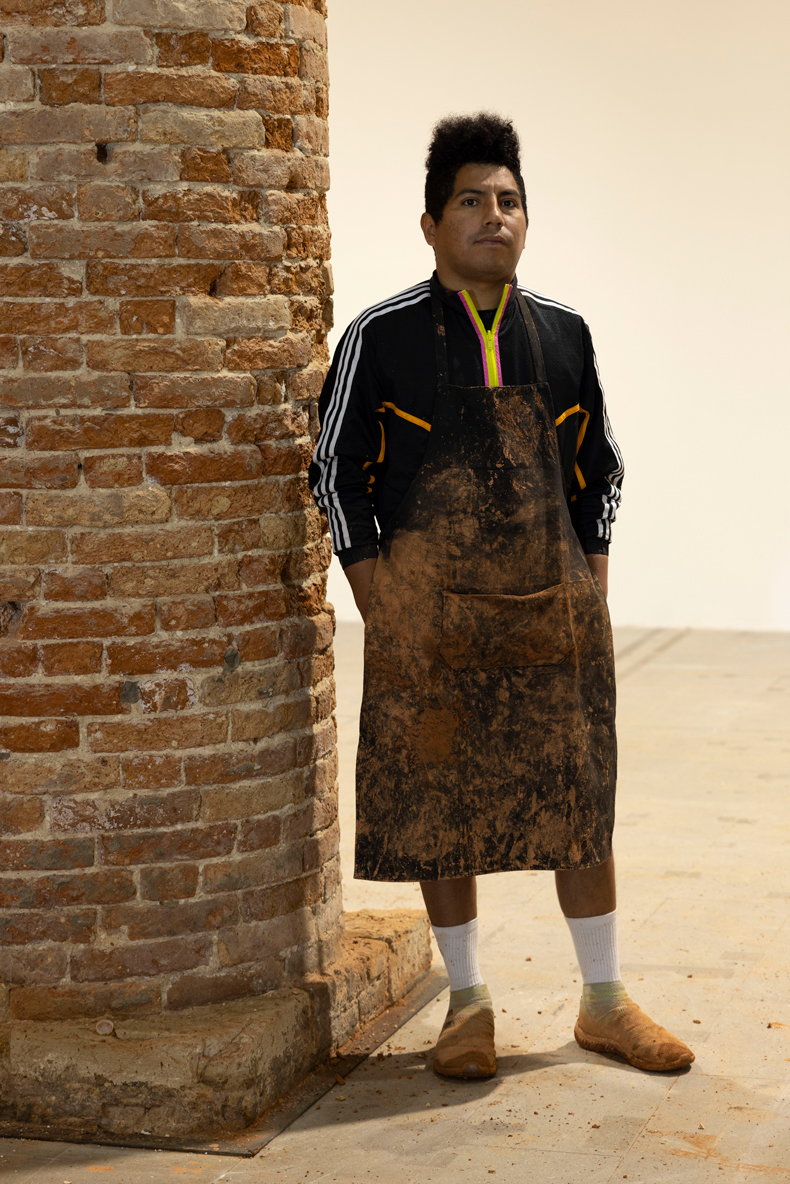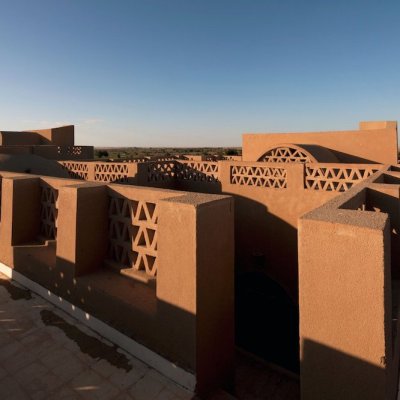Forget the exhibition – as we stand in Studio Voltaire in south London, Gabriel Chaile is enthusing over the collection of ceramics he has been accumulating. Some are on show here, lining a window sill and placed on a small step: their brown glazed surfaces contrasted with the deep red of the raw adobe mix that the Argentinian artist has clad across every centimetre of the gallery’s walls.
Why this preoccupation with pottery? ‘I started to collect Portuguese ceramics, but the first ones I bought were from antique shops or markets in Argentina. I became interested in how these objects had a migrant story and, as I started travelling more for work, I started buying other objects that come from one culture but somehow ended up in another place entirely.’ He adds: ‘An object starts with one purpose or a specific cultural context, but as it goes through the generations, its meaning evolves with each person who uses it.’
He shows me a Mexican urn he bought in New York and his latest acquisition, an Ethiopian jug, found in a shop down the road in Brixton. That these objects are now out of place and time, and have accumulated a new history on their travels, parallels Chaile’s own sculptures in adobe and what he calls the ‘genealogy of form.’ Each work is an amalgamation of references, including forms borrowed from pots in his burgeoning collection, from the pre-Columbian craft traditions of Tucumán, the north west Argentinian province in which Chaile grew up (the artist is of Spanish, Afro-Arab and Indigenous Candelaria heritage), and from the cartoons and anime he loves. Ancient or modern, each reference point comes with its own accumulated history.
Gabriel Chaile. Photo: Andrea Rossetti; courtesy the artist and ChertLüdde

The centrepiece to this show is a large, rotund sculpture: an abstract ‘portrait’ of his friend Laura Ojeda Bär, an artist whose paintings are hung along the muddy walls. Chaile’s work, made by packing a mix of dirt, clay and straw around a spheroid metal support, is far from representational. Nevertheless, the cuts and carvings into the muddy surface are inspired by the artist’s memories of his subject. Bär is just the latest in a long line of Chaile’s friends and family who have acted as muses in this fashion. His contribution to the 2022 Venice Biennale, a tribute to his family, featured five anthropomorphised cooking structures crafted from adobe. Each oven had its own personality and unique physical attributes, with neck-like chimneys of varying lengths and gaping holes for emoji-like mouths. Such ovens are functional and often used in the cooking of communal meals. Chaile used For Diego (Portrait of Diego Núñez) (2018) to cook empanadas in the working-class area of La Boca in Buenos Aires; it was an unusually convivial memorial to a local man killed by police. After its unveiling during Art Basel Cities festival in 2018, For Diego was donated to a community outreach group, who installed it in its current position on the waterfront.
Installation view of work at the Venice Biennale (2022), Gabriel Chaile. Photo: Andrea Rossetti; courtesy Barro Arte Contemporáneo, Gabriel Chaile and ChertLüdde

‘The portrait for me isn’t about what someone looks like, but a way of folding together the hard times we might have shared or the happy moments that left a mark. I want these sculptures to gather up those memories,’ says the artist. Bär is with us, acting as an interpreter for the Spanish-speaking artist; she jokes that you can tell that this latest sculpture is dedicated to her thanks to its small incised eyes. However, Chaile describes how the swooping lines on its surface that roughly sketch arms and hands, and the patterns he has drawn into the bed of soil on which the monumental work stands, were inspired by Bär’s own Francis Bacon-esque painting. ‘It’s a portrait of her as an artist and the movement and sense of distortion she has in her own work.’
Installation view of ‘Usos y Costumbres: Gabriel Chaile in collaboration with Laura Ojeda Bär’ at Studio Voltaire, London. Photo: Sarah Rainer; courtesy the artists and Studio Voltaire

For the exhibition at Studio Voltaire, Chaile invited Bär to make a series of new paintings to be paired with his work. Alongside her portraits – most notably of Chaile – she has produced depictions of artworks both ancient and modern to be found in London museums. Among these are highly contested objects from the British Museum, such as the carved Moai heads from Rapa Nui (Easter Island) and the granite bust of Egyptian pharaoh Ramesses II.
Considering Chaile’s own archeological inspirations, this makes some sense – but is this also a commentary on current debates over repatriation? Chaile and Bär are emphatic in stating that their interest is more nuanced than that. ‘I am indebted to non-Western knowledge and to a different understanding of time, in which the past is folded into the present – many Indigenous cosmologies have a completely different way of registering reality,’ says Chaile. ‘Objects can’t be defined by one singular context or one moment in a linear understanding of history.’ It’s this perspective that speaks, perhaps, to the otherworldliness one can feel in Chaile’s sculpture.
‘Usos y costumbres: Gabriel Chaile in collaboration with Laura Ojeda Bär’ is at Studio Voltaire in London until 10 September.



